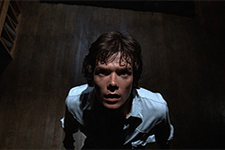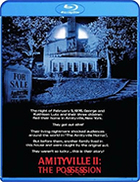Amityville II: The Possession
|  Amityville II: The Possession is intriguingly ambiguous in the way it could be either a prequel or a sequel to The Amityville Horror (1979), which was based on the purported real-life haunting of a three-story colonial-style house on Long Island that drove the Lutz family in late 1975 away after they had lived there only 28 days. The story of the Lutzes’ trauma was preceded a year earlier by the slaughter of an entire family inside the house by the family’s oldest sibling, 23-year-old Ronald “Butch” DeFeo Jr., who claimed at one point to have heard voices (although the reliability of those claims have been called into question). Amityville II is based on the 1979 book Murder in Amityville by parapsychologist and prolific author Hans Holzer, which theorizes that Ronald was possessed. The film version follows that idea, but changes the DeFeos to the fictional Montelli family and appears to be taking place in the early 1980s (one character, for example, has a Sony Walkman, which was introduced in 1979), several years after the Lutzes lived there, although they are never mentioned. So—are we watching a fictionalized version of the DeFeos family’s experience or a story about a fictional family occupying the house after the Lutzes? Who knows? The film opens with the Montelli family arriving at the house on 112 Ocean Avenue, which they have just purchased. They seem happy enough at first, but it quickly becomes evident that there are fissures and tensions in the family unit, starting with the abusive patriarch Anthony (Burt Young), whose explosive temper is usually directed at his oldest son, Sonny (Jack Magner), which raises the ire of Dolores (Rutanya Alda), his cowed, devoutly Catholic wife. Sonny has an uncomfortably close relationship with his teenage sister Patricia (Diane Franklin), while the two youngest members of the family, Jan (Erika Katz) and Mark (Brent Katz), are also the recipients of their father’s violence, especially when they get blamed for the various damage caused by the evil spirit haunting the house. Said spirit is released on move-in day from a dank, foul-smelling room that is discovered behind a wall in the basement, and after causing havoc around the house—grabbing people’s arms, rustling window curtains, covering the family crucifix with a table cloth, painting obscene messages on the bedroom wall with the kids’ paintbrush—it sets its sights on Sonny, first suggesting through his Walkman earphones that he kill his family, and when that fails, outright possessing him, which leads to the anticipated family slaughter and then a dragged-out third act that is basically another retread of the second half of the The Exorcist (1973), complete with a sympathetic, guilt-ridden priest (James Olson) demanding that the spirit take him. Exorcist II was produced by Italian mega-producer Dino De Laurentiis, who had moved his operations to the United States ten years earlier and had already produced a string of often critically lambasted, but always interesting films, including the Charles Bronson vigilante vehicle Death Wish (1974), the exploitative plantation drama Mandingo (1975), the big-budget remake of King Kong (1976), and the campy Flash Gordon (1980). De Laurentiis, who at one time had produced several films by Federico Fellini, was involved in a number of horror productions in the 1980s, including Halloween II (1981) and Halloween III: Season of the Witch (1983) and the Stephen King adaptations The Dead Zone (1983), Cat’s Eye (1985), Silver Bullet (1986), and Maximum Overdrive (1986). Amityville II was one of his first horror efforts, and he brought in Italian director Damiano Damiani, who was at the time best known for his socially aware crime dramas like Confessions of a Police Captain (1971). Damiani was a bit of a strange choice in this regard, but he was clearly committed to the material, as he piles on every horror device imaginable and then some. He and cinematographer Franco Di Giacomo (The Night of Shooting Stars, Il Postino) are particularly aggressive with camera movement, using the gliding Steadicam to represent the evil spirit’s perspective as it first taunts and then later stalks and terrorizes family members. The camera also spins wildly around characters, takes extreme high angles over them, and bounces up and down on them. Damiani clearly loves atmosphere, as numerous scenes are bathed in mist and diffused light and he never misses an opportunity to take advantage of the house’s slanted attic windows, which create the menacing look of a scowling face. He establishes an eerie mood at the very beginning with a slow tracking shot around the mist-shrouded house early in the morning as it sits vacant and forlorn, just waiting for another victim to move in. Amityville II works on various levels, and in some ways it is superior to Stuart Rosenberg’s The Amityville Horror, much of which plays like a made-for-TV movie. Jack Magner, who retired from acting soon after this film, makes for a credible victim of possession; even before he is encased in various make-up effects and air bladders to give him a truly demonic appearance, he slides cannily between seemingly normal and something-not-right. He also has an intriguing interplay with Diane Franklin’s Patricia, who is the film’s true innocent and victim. However, by the film’s final act, the special effects technicians have taken over almost completely, turning it from a parapsychological drama of some merit into a more conventional latex freakshow, the culmination of which is Sonny ripping his own face open to reveal some kind of demonic monstrosity that looks more like an alien. As far as gory horror goes, it’s an effective moment, but also one that reminds us of how heavily reliant the genre had become on prosthetic effects by the early ’80s.
Copyright © 2017 James Kendrick Thoughts? E-mail James Kendrick All images copyright © MGM / Shout! Factory | |||||||||||||||||||||||||||||||
Overall Rating: 

 (2.5)
(2.5)


 Amityville II: The Possession is available as part of the “Amityville Horror Trilogy” boxset, which also includes The Amityville Horror (1979) and Amityville 3-D (1983).
Amityville II: The Possession is available as part of the “Amityville Horror Trilogy” boxset, which also includes The Amityville Horror (1979) and Amityville 3-D (1983).